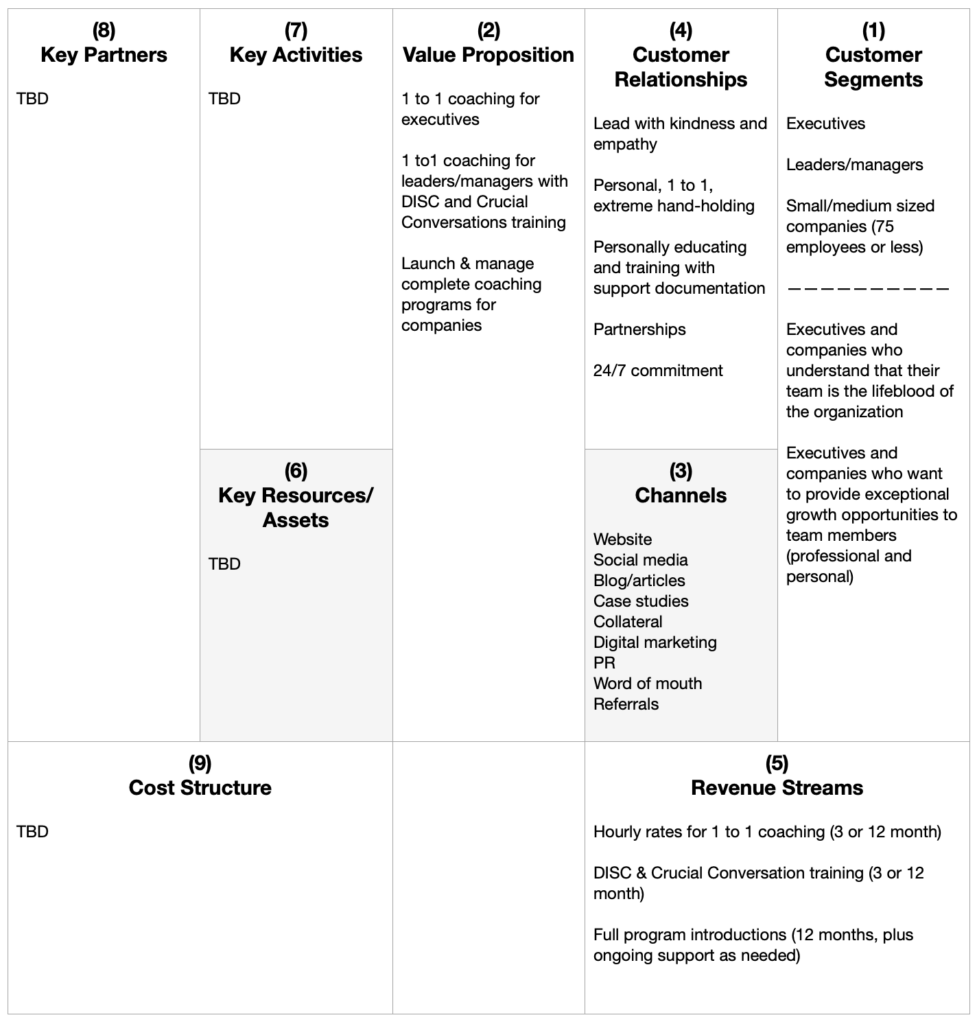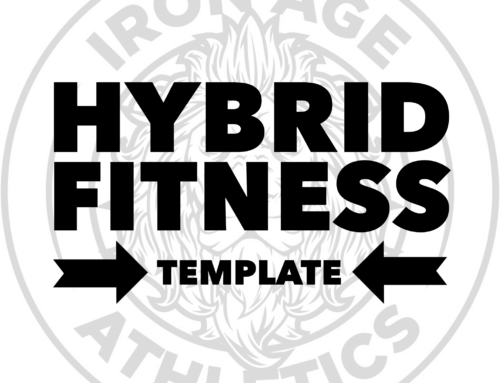BMK Coaching Case Study (part 1 and 2)
Part 1:
One of the best tools to fully understand your business and how it will launch, change & innovate as it grows and responds to new dynamics in the market, is the Business Model Canvas. The Canvas is one of many tools we will be walking BMK Coaching through as the business is getting ready to launch.
This will be accomplished through a multi-day Business Model Canvas PLUS consulting experience which I have developed through years of experience on executive teams and the launch of my own brand, Iron Age Athletics.
Steps:
1) Quickly define the problem and solution (high level)
2) Complete first pass of the Business Model Canvas
3) Create an empathy map for main/top customer segment
4) Document driving forces and SWOT
5) Determine if a quick Blue Ocean four actions framework might provide differentiation options (now in in the future)
6) Complete two custom documents: Phases and Pillars
7) Draft an initial simplified One Page Strat Plan (capturing action items for the next 3 months)
8) Prep a future/working Model Business Model Canvas
This is a great exercise/process for entrepreneurs or small businesses who may not have had the time to slow down and think about the business outside of the initial product/service offering.
The following is a recap of our first session:
Problem/Opportunity:
Employees (anyone really) are not being completely heard.
Managers/companies are not equipped with the skillset or processes and programs that will allow their team members to grow professionally or personally.
Solution/Business Model:
Introduce coaching programs into companies and educate leaders, managers and team members how to utilize bi-weekly sessions to ensure:
- Team members are being heard (completely)
- Offer professional and personal growth opportunities
- Replace antiquated performance review methods with a new model that ensure team members are happy, healthy and productive
- Increase individual, team and company accountability
- Improve top and bottom lines
BMK Business Model Canvas – for Launch

Summary of Session 1
While session 1 was short, we were able to quickly define the problem/opportunity and complete the first half of the Business Model Canvas.
- Getting specific on who BMK coaching is solving the problem for, lead right into section 1 of the Business Model Canvas – the customer segments
-
- This gave BMK clarity on who the initial target customers will be, providing focus for acquisition strategies and tactics
-
- Section 2, the value proposition now can be more focused as well – knowing exactly who BMK is providing this for
-
- BMK is taking a three tiered approach to it’s offering which may increase their ability to get executives onboard, if they are able to experience the benefits of this style of coaching themselves
-
- Section 3 outlines how BMK will reach its customer segments, understanding that some educating will have to take place here. BMK also realized that their large network will be a key starting point as getting referrals will be where they place their initial efforts
- Section 4 lead to some insights as to just how intensive and time consuming the relationships will be. With a commitment to so many 1 to 1 experiences, the number of clients served might be smaller than expected – and the size of companies might have to be much smaller than expected as well.
- Given that clarity, the revenue piece can be better understood, knowing that there will be a cap to number of experiences offered or number of company-wide introductions that can be realistically completed each year
The next session we have will focus on the second half of the Canvas, which will outline just how BMK will make all of this work.
—————————————
Part 2:
In session 2, we completed the initial Business Model Canvas, which you can see below, which also included some additions/edits to sections we completed in session 1.
BMK Business Model Canvas – for Launch

Pre-Launch Activities:
- Sales and marketing material including main pitch deck (value to people, value to managers, value to company)
- For complete programs, show dollar-driven returns
- Define the qualities of a BMK trained coach (kindness, hearing, caring)
- Company kick-off presentation
Summary of Session 2
In session 2, we focused on the back half of the Business Model Canvas while simultaneously looking at the whole. This allowed us to make a few edits/additions to the work we completed in session 1 while starting to get a better idea of how all the pieces work together.
- Section 1 (Customer Segments) went unchanged – but as we started digging deeper into the Activities section, we realized the amount of work and time needed to manage a complete program for companies started to get overwhelming very quickly.
-
- This gave BMK some additional homework to determine the maximum size of companies they could deliver a full program to and at what points would they need to bring in additional coaches (either on volume alone, or volume plus value offerings like DISC training or 360 reviews, etc.)
-
- Section 2 (Value Proposition) started to look more like just the offering vs. what the customers would get from that offering.
-
- While BMK is still taking a three tiered approach, they want to lead with the biggest offering/value – which is everyone gets coaching
- Looking more at the value of these offerings, BMK realized documenting the outcomes will be critical:
-
- Happy, healthy, productive team members
- Engaged team members, more likely to deliver insights and drive innovation
- And also helping companies determine a return (with case studies – such as one manufacturing company increasing margins on their cash cow product from 65% to 90%)
-
-
- Section 3 (Channels) went largely unchanged as well, but the new insight here was that BMK will have to manage direct selling itself. As a start-up of one or a few, most, if not all activities will fall on limited shoulders (which got BMK thinking more deeply about Partners).
- Section 4 (Customer Relationships) had one big addition – “On site”. BMK feels, at least initially, in order for a full program to start well and gain momentum – it as to be delivered in person, with BMK being on site for a significant amount of time.
-
- This could limit the customer segments
- But more important, perhaps, is how much it will impact the cost structure, and what BMK will have to charge remote customers
-
- Section 5 (Revenue Streams) had a few changes – the biggest being BMK needs to “work on math” – getting clear, given the amount of Activities needed in a full company-wide program, what is the max company size they can take on alone.
-
- They also realized that some managers will never be good “heart coaches” and this may be another opportunity for BMK to step in and fill that void
-
- Section 6 (Key Resources/Assets) – if BMK had a physical product or was manufacturing based, this section would be much more significant.
-
- However, the realization as we got more into the Activities section, is that the #1 resource BMK has is their time.
- And that time is going to get accounted for very quickly with full, company wide programs
- They also realized that additional certifications could add more value to their core customers (and could be accounted for in Partnerships, until they acquired it themselves)
-
- Section 7 (Key Activities) – the revelation here is that these added up very fast and that there are a lot more to capture.
-
- Because BMK is still pre-launch, we divided the activities into pre- and post-launch (ideally, the activities captured in the Business Model Canvas are those required to deliver the Value Proposition)
- But, the benefit of doing this exercise in the early stages of a launch, is that you quickly realize there a dozens and dozens of activities needed pre-launch that you need to capture and map out (in this case, a lot of sales and marketing collateral)
- The ongoing story here is that BMK (for now) is a one person show, and in order to deliver the value proposition to an entire company, the number of activities and time to complete them added up fast. So getting a real handle of the entirety of these is critical.
- BMK must understand this fully to get the costs and revenue right – as well as flushing out how specific Partnerships could be critical to the business model
-
- Section 8 (Key Partners) – as discussed above, this piece could be critical for BMK to get right if they hope to offer full programs to companies other than those that are quite small to medium in size.
-
- It also might be a way for BMK to offer additional value to customers with coaching partners who have different skill sets (DISC, 360’s, Strength Finders, etc.)
-
- Section 9 (Cost Structure) – no huge revelations here other than knowing lengthy on site opportunities will fluctuate the costs significantly.
-
- And again, back to the numbers came … what costs will vary depending on customer size and the extent of extra deliverables, like DISC training.
-
The next session we will spend time outlining the Driving Forces that may be affecting the business model today and in the future, as well as completing a SWOT analysis (to see if it lines up with the value proposition).




